 W
WThe Aladža Mosque (also known as Šarena džamija is a mosque in Foča in the east of Bosnia and Herzegovina. It is considered one of the most architecturally important in the European part of the Ottoman Empire, the then Rumelia, and one of the three most important mosques in Bosnia and Herzegovina, with the Gazi Husrev-beg Mosque in Sarajevo and the Ferhadija Mosque in Banja Luka. It was built in 1550 and blown up in 1992; its reconstruction was completed between 2016 and 2018.
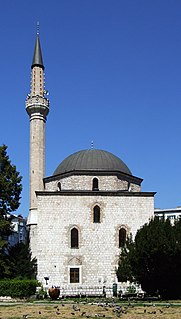 W
WAli Pasha Mosque or Alipašina džamija was constructed in Sarajevo during 1560–61 as a vakıf of Sofu Hadım Ali Pasha, the Ottoman former governor of the Bosnia Eyalet of the Ottoman Empire, after his death in September 1560.
 W
WČobanija Mosque was constructed in Sarajevo, Bosnia and Herzegovina, before 1565. The building is quite spacious, with a fine stone minaret. Set into the walls around the minaret is a poem in Turkish. There is a cemetery adjacent to the mosque, which some believe is the final resting place of the benefactor, Čoban-Hasan.
 W
WFerhadija Mosque, also known as Ferhat-Pasha Mosque, Ferhad-beg Vuković Mosque, is a central building in the city of Sarajevo built by Bosnian Sanjak-bey (governor) Ferhad-beg Vuković, a descendant of the famous mediaeval Vuković-Desisalić family. This mosque has one dome above the prayer area and three small domes at the cloister and is one of the greatest achievements of Bosnia and Herzegovina’s 16th century Ottoman and Islamic architecture.
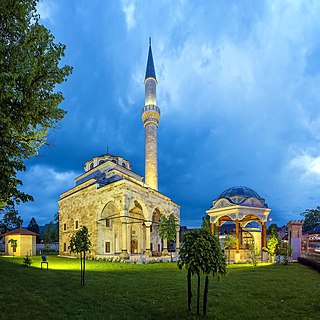 W
WFerhat Pasha Mosque, also known as the Ferhadija Mosque, is a central building in the city of Banja Luka and one of the greatest achievements of Bosnia and Herzegovina's 16th century Ottoman Islamic architecture in Europe. The mosque was demolished in 1993 at the order of the authorities of Republika Srpska, and was rebuilt and opened on 7 May 2016.
 W
WFehtija Mosque is a mosque and former Catholic church located in the town of Bihać, Bosnia and Herzegovina. Built in 1266, it is the oldest gothic building in the country. It was originally built as a Catholic church dedicated to Saint Anthony of Padua, and was subsequently transformed into a mosque following the 1592 conquest of Bihać from Habsburg Croatia by the Ottomans. The building was originally accompanied by a monastery, which was also mentioned in a 13th-century charter of the Croatian nobility.
 W
WGazi Husrev-beg Mosque is a mosque in the city of Sarajevo, Bosnia and Herzegovina. Built in the 16th century, it is the largest historical mosque in Bosnia and Herzegovina and one of the most representative Ottoman structures in the Balkans. Being the central Sarajevo's mosque since the days of its construction, today it also serves as the main congregational mosque of the Islamic Community of Bosnia and Herzegovina. It is located in the Baščaršija neighborhood in the Stari Grad municipality and, being one of the main architectural monuments in the town, is regularly visited by tourists.
 W
WThe Vekil-Harrach or Hadžijska mosque is a mosque in the city of Sarajevo, Bosnia and Herzegovina. It is located in Alifakovac, a neighborhood in Babića bašća local community, one of the oldest urban settlements in Sarajevo.
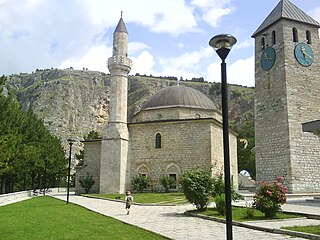 W
WThe Hajji Ahmed the Ducat Minter's Mosque is one of the most easily recognizable architectural symbols of Livno, Bosnia and Herzegovina.
 W
WKaragöz Bey Mosque is a 16th-century Ottoman mosque in the city of Mostar, Bosnia and Herzegovina.
 W
WMehmed Pasha Kukavica Mosque was one of five mosques in Foča town, in Bosnia and Herzegovina which typologically belonged to a single-space domed mosque with an open exterior portico. It was located in Gornja (Upper) čaršija, and completely destroyed during the Bosnian War. Built in 1751, it was a part of an architectural ensemble consisting of the mosque, medresa, clock tower and hammam, all endowments of Foča-born Mehmed-paša Kukavica, one of the most prominent Ottoman governors of Bosnia.
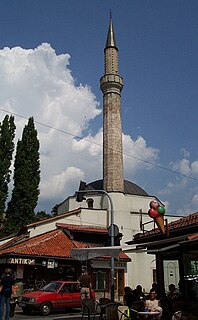 W
WMuslihudin Čekrekčija Mosque is second oldest domed mosque in Sarajevo. Construsted in 1526, in the Baščaršija area of the city., at the foot of Kovač. It is raised in the mahala of Isa-Bey's turn. From the vakufname of the founder of the mosque, we learn that Hajji Mustafa, the son of Ishak, is known to the people as Muslihudin Čekrekčija, her builder. This is also the oldest known original document written in Sarajevo. It was found in the legacy of Muhamed Enver ef. Kadić.
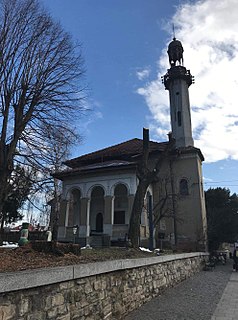 W
WThe Atik Behram-begova džamija, better known as Šarena džamija, is the oldest mosque in Tuzla, Bosnia and Herzegovina.